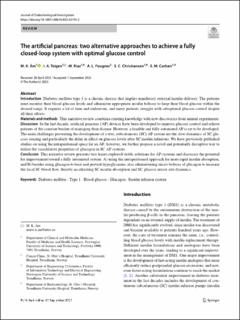| dc.contributor.author | Åm, Marte Kierulf | |
| dc.contributor.author | Teigen, Ingrid Anna | |
| dc.contributor.author | Riaz, Misbah | |
| dc.contributor.author | Fougner, Anders Lyngvi | |
| dc.contributor.author | Christiansen, Sverre Christian | |
| dc.contributor.author | Carlsen, Sven Magnus | |
| dc.date.accessioned | 2023-11-08T14:42:00Z | |
| dc.date.available | 2023-11-08T14:42:00Z | |
| dc.date.created | 2023-09-01T13:24:35Z | |
| dc.date.issued | 2023 | |
| dc.identifier.issn | 0391-4097 | |
| dc.identifier.uri | https://hdl.handle.net/11250/3101489 | |
| dc.description.abstract | Introduction Diabetes mellitus type 1 is a chronic disease that implies mandatory external insulin delivery. The patients must monitor their blood glucose levels and administer appropriate insulin boluses to keep their blood glucose within the desired range. It requires a lot of time and endeavour, and many patients struggle with suboptimal glucose control despite all their efforts. Materials and methods This narrative review combines existing knowledge with new discoveries from animal experiments. Discussion In the last decade, artificial pancreas (AP) devices have been developed to improve glucose control and relieve patients of the constant burden of managing their disease. However, a feasible and fully automated AP is yet to be developed. The main challenges preventing the development of a true, subcutaneous (SC) AP system are the slow dynamics of SC glucose sensing and particularly the delay in effect on glucose levels after SC insulin infusions. We have previously published studies on using the intraperitoneal space for an AP; however, we further propose a novel and potentially disruptive way to utilize the vasodilative properties of glucagon in SC AP systems. Conclusion This narrative review presents two lesser-explored viable solutions for AP systems and discusses the potential for improvement toward a fully automated system: A) using the intraperitoneal approach for more rapid insulin absorption, and B) besides using glucagon to treat and prevent hypoglycemia, also administering micro-boluses of glucagon to increase the local SC blood flow, thereby accelerating SC insulin absorption and SC glucose sensor site dynamics. | en_US |
| dc.language.iso | eng | en_US |
| dc.publisher | Springer | en_US |
| dc.rights | Navngivelse 4.0 Internasjonal | * |
| dc.rights.uri | http://creativecommons.org/licenses/by/4.0/deed.no | * |
| dc.subject | Vasodilatasjon | en_US |
| dc.subject | Vasodilation | en_US |
| dc.subject | Intraperitoneal insulininfusjon | en_US |
| dc.subject | Intraperitoneal insulin infusion | en_US |
| dc.subject | Type 1 diabetes | en_US |
| dc.subject | Type 1 diabetes | en_US |
| dc.subject | Glukagoninfusjon | en_US |
| dc.subject | Glucagon infusion | en_US |
| dc.title | The Artificial Pancreas: Two Alternative Approaches to Achieve a Fully Closed Loop System with Optimal Glucose Control | en_US |
| dc.title.alternative | The Artificial Pancreas: Two Alternative Approaches to Achieve a Fully Closed Loop System with Optimal Glucose Control | en_US |
| dc.type | Peer reviewed | en_US |
| dc.type | Journal article | en_US |
| dc.description.version | publishedVersion | en_US |
| dc.subject.nsi | VDP::Medisinsk teknologi: 620 | en_US |
| dc.subject.nsi | VDP::Medical technology: 620 | en_US |
| dc.source.journal | Journal of Endocrinological Investigation | en_US |
| dc.identifier.doi | 10.1007/s40618-023-02193-2 | |
| dc.identifier.cristin | 2171680 | |
| dc.relation.project | Norges forskningsråd: 294828 | en_US |
| dc.relation.project | Norges forskningsråd: 248872 | en_US |
| dc.relation.project | Norges forskningsråd: 332850 | en_US |
| cristin.ispublished | true | |
| cristin.fulltext | original | |
| cristin.qualitycode | 1 | |

